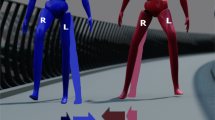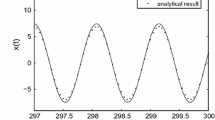The emergence of the pedestrian-induced bridge instability is conventionally associated with crowd synchrony; however, this view has been challenged. In this paper, we use a bio-mechanical pedestrian model in the form of an active inverted pendulum to analyze the average contribution of a single pedestrian to possibly uncorrelated crowd dynamics and bridge oscillations. We obtained that depending on the ratio of the bridge vibration and walking frequencies, the pedestrian can amplify bridge vibration or, surprisingly, extract energy from the bridge and damp bridge oscillations. In particular, we show that different combinations of the bridge and pedestrian step frequencies corresponding to the same or close frequency ratios can trigger two drastically different bridge dynamics, with enhanced or suppressed oscillations far from the resonances.
Similar content being viewed by others
References
Oeuvres Complétes de Christian Huygens. Publ. par la Sociètè hollandaise des sciences. Vol. 5, Correspondance 1664–1665, M. Nijhoff, La Haye (1893).
M. Bennett, M. F. Schatz, H. Rockwood, and K. Wiesenfeld, Proc. Royal Soc. A: Math., Phys. and Engin. Sci., 458, 563–579 (2002). https://doi.org/10.1098/rspa.2001.0888
A. Pikovsky, M. Rosenblum, and J. Kurths, Synchronization: A Universal Concept in Nonlinear Sciences, Cambridge University Press (2003).
J. Pena Ramirez, L. A. Olvera, H. Nijmeijer, and J. Alvarez, Sci. Rep., 6, 23580 (2016). https://doi.org/10.1038/srep23580
L. M. Pecora and T. L. Carroll, Phys. Rev. Lett., 80, 2109 (1998). https://doi.org/10.1103/PhysRevLett.80.2109
S. H. Strogatz, Nature, 410, 268–276 (2001). https://doi.org/10.1038/35065725
S. Boccaletti, J. Kurths, G. Osipov, D. Valladares, and C. Zhou, Phys. Rep., 366, 1–101 (2002). https://doi.org/10.1016/S0370-1573(02)00137-0
V. N. Belykh, I. V. Belykh, and M. Hasler, Phys. D: Nonlin. Phenom., 195, 159–187 (2004). https://doi.org/10.1016/j.physd.2004.03.012
T. Nishikawa and A. E. Motter, Proc. Nat. Acad. Sci. USA, 107, 10342–10347 (2010). https://doi.org/10.1073/pnas.0912444107
A. J. Whalen, S. N.Brennan, T. D. Sauer, and S. J. Schiff, Phys. Rev. X, 5, 011005 (2015). https://doi.org/10.1103/PhysRevX.5.011005
H. Abarbanel, M. I.Rabinovich, A. Selverston, M. Bazhenov, R. Huerta, M. Sushchik, and L. Rubchinskii, Phys. Usp., 39, 337–362 (1996). https://doi.org/10.1070/PU1996v039n04ABEH000141
A. Szücs, R. Huerta, M. I.Rabinovich, and A. I. Selverston, Neuron, 61, 439–453 (2009). https://doi.org/10.1016/j.neuron.2008.12.032
R. C. Elson, A. I. Selverston, H. D.Abarbanel, and M. I.Rabinovich, J. Neurophys., 88, 1166–1176 (2002). https://doi.org/10.1152/jn.2002.88.3.1166
R. Roy and K. S. Thornburg Jr., Phys. Rev. Lett., 72, 2009 (1994). https://doi.org/10.1103/PhysRevLett.72.2009
S. Shahin, F. Vallini, F. Monifi, et al., Opt. Lett., 41, 5238–5241 (2016). https://doi.org/10.1364/OL.41.005238
J. Ding, I. Belykh, A. Marandi, and M.-A.Miri, Phys. Rev. Appl., 12, 054039 (2019). https://doi.org/10.1103/PhysRevApplied.12.054039
A.E. Motter, S. A.Myers, M. Anghel, and T. Nishikawa, Nat. Phys., 9, 191–197 (2013). https://doi.org/10.1038/nphys2535
I. Belykh, M. Bocian, A. Champneys, et al., Nat. Commun., 12, 7223 (2021). https://doi.org/10.1038/s41467-021-27568-y
Y. Fujino, B. M.Pacheco, S.-I. Nakamura, and P. Warnitchai, Earthquake Eng. Struct. Dyn., 22, 741–758 (1993). https://doi.org/10.1002/eqe.4290220902
F. Danbon and G. Grillaud, in: Proc. Footbridge-2nd Int. Conf. Dec., Venice, Italy, 10075051 (2005).
P. Dallard, A. Fitzpatrick, A. Flint, S. Le Bourva, A. Low, R. Ridsdill Smith, and M. Willford, Struct. Eng., 79, 17–21 (2001).
S. Nakamura, Struct. Eng., 81, 22–26 (2003).
J. M. Brownjohn, P. Fok, M. Roche, and P. Omenzetter, Struct. Eng., 82, 21–27 (2004).
J. Macdonald, in: Proc. Inst. Civil Engineers–Bridge Eng., 161, No. 2, 69–77 (2008). https://doi.org/10.1680/bren.2008.161.2.69
E. Caetano, Á. Cunha, F. Magalhães, and C. Moutinho, Eng. Struct., 32, 1069–1081 (2010). https://doi.org/10.1016/j.engstruct.2009.12.034
I. Belykh, R. Jeter, and V. Belykh, Sci. Adv., 3, e1701512 (2017). https://doi.org/10.1126/sciadv.1701512
S. H. Strogatz, D. M. Abrams, A. McRobie, et al., Nature, 438, No. 7064, 43–44 (2005). https://doi.org/10.1038/438043a
B. Eckhardt, E. Ott, S. H. Strogatz, et al., Phys. Rev. E, 75, 021110 (2007). https://doi.org/10.1103/PhysRevE.75.021110
M. M. Abdulrehem and E. Ott, Chaos, 19, 013129 (2009). https://doi.org/10.1063/1.3087434
J. H. Macdonald, Proc. Roy. Soc. of London A: Math., Phys. Eng. Sci., 465, 1055-1073 (2008).
M. Bocian, J. Macdonald, and J. Burn, J. Sound Vibr ., 331, 3914–3929 (2012). https://doi.org/10.1016/j.jsv.2012.03.023
I. V. Belykh, R. Jeter, and V. N. Belykh, Chaos, 26, 116314 (2016). https://doi.org/10.1063/1.4967725
V. S.Afraimovich, N. N.Verichev, and M. I.Rabinovich, Radiophys. Quantum Electron., 29, No. 9, 795–803 (1986). https://doi.org/10.1007/BF01034476
C. Barker, in: Proc. Footbridge 1st Int. Conf., Paris, 20–22 November, 2002 , 10006505.
A. Hof, R. M. van Bockel, T. Schoppen, and K. Postema, Gait and Posture, 25, No. 2, 250–258 (2007). https://doi.org/10.1016/j.gaitpost.2006.04.013
A. Hof, S. Vermerris, and W. Gjaltema, J. Exper. Biol., 213, 2655–2664 (2010). https://doi.org/10.1242/jeb.042572
C. D. MacKinnon and D. A. Winter, J. Biomech., 26, 633–644 (1993). https://doi.org/10.1016/0021-9290(93)90027-C
A.A.Andronov, A.A.Vitt, and S. E.Khaikin, Theory of Oscillators, Pergamon, London (1966).
K. F.Teodorchik, Self-Oscillating Systems [in Russian], Gostekhizdat, Moscow (1952).
V. N. Belykh and M. I.Rabinovich, in: Fiz. Enzikl, Vol. 2, Soviet Encyclopedia, Moscow (1990), pp. 38-39.
Author information
Authors and Affiliations
Corresponding author
Additional information
Translated from Izvestiya Vysshikh Uchebnykh Zavedenii, Radiofizika, Vol. 64, No. 10, pp. 777–786, October 2021. Russian DOI: https://doi.org/10.52452/00213462_2021_64_10_777
Rights and permissions
About this article
Cite this article
Belykh, I., Daley, K.M. & Belykh, V.N. Pedestrian-Induced Bridge Instability: The Role of Frequency Ratios. Radiophys Quantum El 64, 700–708 (2022). https://doi.org/10.1007/s11141-022-10172-5
Received:
Accepted:
Published:
Issue Date:
DOI: https://doi.org/10.1007/s11141-022-10172-5




